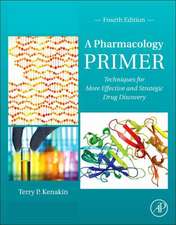Computational Drug Discovery and Design: Methods in Molecular Biology, cartea 819
Editat de Riccardo Baronen Limba Engleză Hardback – 21 dec 2011
Thorough and intuitive, Computational Drug Discovery and Design: Methods and Protocols aids scientists in the continuing study of state-of-the-art concepts and computer-based methodologies.
| Toate formatele și edițiile | Preț | Express |
|---|---|---|
| Paperback (1) | 1122.05 lei 6-8 săpt. | |
| Humana Press Inc. – 23 aug 2016 | 1122.05 lei 6-8 săpt. | |
| Hardback (1) | 1445.88 lei 6-8 săpt. | |
| Humana Press Inc. – 21 dec 2011 | 1445.88 lei 6-8 săpt. |
Din seria Methods in Molecular Biology
- 9%
 Preț: 791.63 lei
Preț: 791.63 lei - 23%
 Preț: 598.58 lei
Preț: 598.58 lei - 20%
 Preț: 882.98 lei
Preț: 882.98 lei -
 Preț: 252.05 lei
Preț: 252.05 lei - 5%
 Preț: 802.70 lei
Preț: 802.70 lei - 5%
 Preț: 729.61 lei
Preț: 729.61 lei - 5%
 Preț: 731.43 lei
Preț: 731.43 lei - 5%
 Preț: 741.30 lei
Preț: 741.30 lei - 5%
 Preț: 747.16 lei
Preț: 747.16 lei - 15%
 Preț: 663.45 lei
Preț: 663.45 lei - 18%
 Preț: 1025.34 lei
Preț: 1025.34 lei - 5%
 Preț: 734.57 lei
Preț: 734.57 lei - 18%
 Preț: 914.20 lei
Preț: 914.20 lei - 15%
 Preț: 664.61 lei
Preț: 664.61 lei - 15%
 Preț: 654.12 lei
Preț: 654.12 lei - 18%
 Preț: 1414.74 lei
Preț: 1414.74 lei - 5%
 Preț: 742.60 lei
Preț: 742.60 lei - 20%
 Preț: 821.65 lei
Preț: 821.65 lei - 18%
 Preț: 972.30 lei
Preț: 972.30 lei - 15%
 Preț: 660.49 lei
Preț: 660.49 lei - 5%
 Preț: 738.41 lei
Preț: 738.41 lei - 18%
 Preț: 984.92 lei
Preț: 984.92 lei - 5%
 Preț: 733.29 lei
Preț: 733.29 lei -
 Preț: 392.60 lei
Preț: 392.60 lei - 5%
 Preț: 746.26 lei
Preț: 746.26 lei - 18%
 Preț: 962.66 lei
Preț: 962.66 lei - 23%
 Preț: 860.22 lei
Preț: 860.22 lei - 15%
 Preț: 652.64 lei
Preț: 652.64 lei - 5%
 Preț: 1055.50 lei
Preț: 1055.50 lei - 23%
 Preț: 883.87 lei
Preț: 883.87 lei - 19%
 Preț: 491.89 lei
Preț: 491.89 lei - 5%
 Preț: 1038.86 lei
Preț: 1038.86 lei - 5%
 Preț: 524.16 lei
Preț: 524.16 lei - 18%
 Preț: 2122.34 lei
Preț: 2122.34 lei - 5%
 Preț: 1299.23 lei
Preț: 1299.23 lei - 5%
 Preț: 1339.12 lei
Preț: 1339.12 lei - 18%
 Preț: 1390.26 lei
Preț: 1390.26 lei - 18%
 Preț: 1395.63 lei
Preț: 1395.63 lei - 18%
 Preț: 1129.65 lei
Preț: 1129.65 lei - 18%
 Preț: 1408.26 lei
Preț: 1408.26 lei - 18%
 Preț: 1124.92 lei
Preț: 1124.92 lei - 18%
 Preț: 966.27 lei
Preț: 966.27 lei - 5%
 Preț: 1299.99 lei
Preț: 1299.99 lei - 5%
 Preț: 1108.51 lei
Preț: 1108.51 lei - 5%
 Preț: 983.76 lei
Preț: 983.76 lei - 5%
 Preț: 728.16 lei
Preț: 728.16 lei - 18%
 Preț: 1118.62 lei
Preț: 1118.62 lei - 18%
 Preț: 955.25 lei
Preț: 955.25 lei - 5%
 Preț: 1035.62 lei
Preț: 1035.62 lei - 18%
 Preț: 1400.35 lei
Preț: 1400.35 lei
Preț: 1445.88 lei
Preț vechi: 1521.98 lei
-5% Nou
Puncte Express: 2169
Preț estimativ în valută:
276.68€ • 295.86$ • 230.68£
276.68€ • 295.86$ • 230.68£
Carte tipărită la comandă
Livrare economică 18 aprilie-02 mai
Preluare comenzi: 021 569.72.76
Specificații
ISBN-13: 9781617794643
ISBN-10: 1617794643
Pagini: 541
Ilustrații: XVII, 628 p.
Dimensiuni: 178 x 254 x 40 mm
Greutate: 1.32 kg
Ediția:2012
Editura: Humana Press Inc.
Colecția Humana
Seria Methods in Molecular Biology
Locul publicării:Totowa, NJ, United States
ISBN-10: 1617794643
Pagini: 541
Ilustrații: XVII, 628 p.
Dimensiuni: 178 x 254 x 40 mm
Greutate: 1.32 kg
Ediția:2012
Editura: Humana Press Inc.
Colecția Humana
Seria Methods in Molecular Biology
Locul publicării:Totowa, NJ, United States
Public țintă
Professional/practitionerCuprins
A Molecular Dynamics Ensemble-Based Approach for the Mapping of Druggable Binding Sites.-Analysis of Protein Binding Sites by Computational Solvent Mapping.-Evolutionary Trace for Prediction and Redesign of Protein Functional Sites.- Information Entropic Functions for Molecular Descriptor Profiling.-Expanding the Conformational Selection Paradigm in Protein-Ligand Docking.-Flexibility Analysis of Biomacromolecules with Application to Computer-aided Drug Design.-On the Use of Molecular Dynamics Receptor Conformations for Virtual Screening.-Virtual Ligand Screening Against Comparative Protein Structure Models.-AMMOS Software: Method and Application.-Rosetta Ligand Docking with Flexible XML Protocols.-Normal Mode-Based Approaches in Receptor Ensemble Docking.-Application of Conformational Clustering in Protein-Ligand Docking.-How to Benchmark Methods for Structure-based Virtual Screening of Large Compound Libraries.-AGGRESCAN: Method, Application, and Perspectives for Drug Design.-ATTRACT and PTOOLS: Open Source Programs for Protein-protein Docking.-Prediction of Interacting Protein Residues using Sequence and Structure Data.-MM-GB/SA Rescoring of Docking Poses.-A Case Study of Scoring and Rescoring in Peptide Docking.-The Solvated Interaction Energy (SIE) Method for Scoring Binding Affinities.-Linear Interaction Energy (LIE): Method and Applications in Drug Design.-Estimation of Conformational Entropy in Protein-Ligand Interactions: a Computational Perspective.-Explicit Treatment of Water Molecules in Data-driven Protein-protein Docking: The Solvated HADDOCKing Approach.Protein–water Interactions in MD Simulations: POPS/POPSCOMP Solvent Accessibility Analysis, Solvation Forces and Hydration Sites.-Computing the Thermodynamic Contributions of Interfacial Water.-Assignment of Protonation States in Proteins and Ligands: Combining pKa Prediction with Hydrogen Bonding Network Optimization.-Best Practices in Free Energy Calculations for DrugDesign.-Independent-Trajectory Thermodynamic Integration:A Practical Guide to Protein-Drug Binding Free Energy Calculations Using Distributed Computing.- Free Energy Calculations from One-step Perturbations.-Using Metadynamics and Path Collective Variables to Study Ligand Binding and Induced Conformational Transitions.-Accelerated Molecular Dynamics In Computational Drug Design.-Molecular Dynamics Applied in Drug Discovery: the Case of HIV-1 Protease.-Decomposing the Energetic Impact of Drug-Resistant Mutations: The Example of HIV-1 Protease-DRV Binding.-Virtual Screening Helps Experiment Design: Application to the Akt Phosphatase PHLPP.- Molecular-Level Simulation of Pandemic Influenza Glycoproteins.-Homology Modeling of Cannabinoid Receptor: Discovery of Cannabinoid Analogues for Therapeutic Use.-High-throughput Virtual Screening Lead to Discovery of Non-peptidic Inhibitors of West Nile Virus NS3 Protease.
Recenzii
From the reviews:
“Given that computational drug design is a rapidly expanding area of research, this book fills a niche that makes it useful for both novices and the more experienced in the field. … this is a practical manual, refitted with many protocols and examples, of how to employ the new techniques being developed by experts in the expanding field of computational drug discovery.” (Jed N. Lampe, Doody’s Book Reviews, July, 2012)
“Given that computational drug design is a rapidly expanding area of research, this book fills a niche that makes it useful for both novices and the more experienced in the field. … this is a practical manual, refitted with many protocols and examples, of how to employ the new techniques being developed by experts in the expanding field of computational drug discovery.” (Jed N. Lampe, Doody’s Book Reviews, July, 2012)
Textul de pe ultima copertă
Due to the rapid and steady growth of available low-cost computer power, the use of computers for discovering and designing new drugs is becoming a central topic in modern molecular biology and medicinal chemistry. In Computational Drug Discovery and Design: Methods and Protocols expert researchers in the field provide key techniques to investigate biomedical applications for drug developments based on computational chemistry. These include methods and techniques from binding sites prediction to the accurate inclusion of solvent and entropic effects, from high-throughput screening of large compound databases to the expanding area of protein-protein inhibition, toward quantitative free-energy approaches in ensemble-based drug design using distributed computing. Written in the highly successful Methods in Molecular Biology™ series format, chapters include introductions to their respective topics, reference to software and open source analysis tools, step-by-step, readily reproducible computational protocols, and key tips on troubleshooting and avoiding known pitfalls.
Thorough and intuitive, Computational Drug Discovery and Design: Methods and Protocols aids scientists in the continuing study of state-of-the-art concepts and computer-based methodologies.
Thorough and intuitive, Computational Drug Discovery and Design: Methods and Protocols aids scientists in the continuing study of state-of-the-art concepts and computer-based methodologies.
Caracteristici
Manual for state-of-the-art concepts and methodologies, as well as an advanced, specialized tool to design novel and orignial research for public health Provides step-by-step detail essential for reproducible results Contains key notes and implementaion advice from the experts






